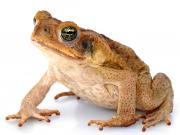Image courtesy of Dr. Brian Gratwicke, Smithsonian Conservation Biology Institute (SCBI)
Materials
- Table 5.1
- Table 5.2
Procedure
- Before beginning the activity, answer question 1 in the Activity Questions below.
- Use the dichotomous key in Table 5.1 to determine the identity of each of organisms in Table 5.2. For each organism,
- record your decisions from Table 5.1 in the Notes section of Table 5.2;
- record the species identity In Table 5.2.
- Compare your species identifications and key steps with another student. Discuss any differences.
- Obtain the true species identifications from your instructor and compare them to your identifications.
- Optional: Using resources available, find an image of an amphibian. Swap images with a classmate and see if you can correctly identify the amphibian.
| Specimen | Key steps and identity |
|---|---|
|
Image copyright and source
|
|
|
Image copyright and source
Image courtesy of Sam Fraser-Smith, Flickr |
|
|
Image copyright and source
Image courtesy of Franco Andreone, Museo Regionale di Scienze Naturali |
|
|
Image copyright and source
Image courtesy of LiquidGhoul, Wikimedia Commons |
|
|
Image copyright and source
Image courtesy of Dr. Brian Gratwicke, Smithsonian Conservation Biology Institute (SCBI) |
|
|
Image copyright and source
Image courtesy of Kerry Matz, Flickr |
|
|
Image copyright and source
Image courtesy of squamatologist, Flickr |
|
|
Image copyright and source
Image courtesy of ZeWrestler, Wikimedia Common |
|
|
Image copyright and source
Image courtesy of LiquidGhoul, Wikimedia Common |
|
|
Image copyright and source
Image courtesy of BjГёrn Christian TГёrrissen, Wikimedia Commons |
|
|
Image copyright and source
Image courtesy of Dr. Brian Gratwicke, Smithsonian Conservation Biology Institute (SCBI) |
- What are amphibians? Before we can begin to use an amphibian dichotomous key, we need to correctly identify the unknown animals as amphibians.
- Write your own definition for “amphibian.” Use simple language that a middle school student would understand.
- What are the shared common features that all amphibians possess?
- The dichotomous key in Table 5.1 only applies to animals identified as amphibians. Closely examine the images in Table 5.2. Are you certain that all of these animals are amphibians? Why or why not?
- Were there any differences between your identifications and the true identifications? Trace your steps working backwards from the correct answer. Where did you make your mistake? Use your mistake to add helpful notes to the dichotomous key for future reference.
- Were there any steps in the dichotomous key that were more challenging than others? Explain.
- Dichotomous keys are always under revision as new species are discovered and described by biologists. Given the opportunity, how would you revise and improve this simple dichotomous key for amphibians?
- If you were shown a photo of a new animal species, what features would you look for to determine if it is an amphibian?
- If you were shown a photo of a new animal species, what features would lead you to identify it as a frog?
- Step 4 of the dichotomous key in Table 5.1 distinguishes “toads” from “frogs.” However, the colloquial term “toad” generally refers only to one family within the frog grouping (order Anura). All toads are frogs, but not all frogs are toads. How would you modify the dichotomous key to reflect this new information?
- The dichotomous key in Table 5.1 provides very broad and general identifications with low taxonomic resolution, or specificity (e.g., it stops at the order level, distinguishing frogs, salamanders, and caecilians).
- Compare this key to other dichotomous keys in this module. What is the importance of taxonomic resolution?
- What are the benefits of such broad general keys like the one found in Table 5.1?
- Describe a real-world situation where general identifications would be sufficient.


















